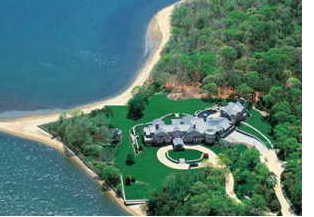
Grass is greener in BurntPoint
The Rich are meaner than you and me.
Solar power for homes is so subsidised, some high-end home owners, never afraid to take whatever handouts are going, are shifting to innovative energy practices–and not for environmental reasons.
The wealthiest American families are using geothermal heating and cooling systems; efficient wind turbines make it a breeze to generate electricity.
“Some of our high-end clients literally never see their energy bills,” says Steven J. Strong, president of Solar Design Associates in Harvard, Mass. “They are putting a higher value on having more control over their energy destiny. This is a hedge against uncertainty.”
The US DOE estimates that average heating costs increased 7% in the US, which takes into account Arizona, Florida and other states with year-round temperate climates. Meanwhile, state and federal incentives help home owners install renewable energy sources or implement energy-efficient strategies in their houses. And those big home owners have big lawyers and acocuntants who sweep up the grants the rest of us cannot get around to.
Those big homes are getting more energy independent, Strong told Forbes magazine. The 2001 California blackouts, the Northeast blackout of 2003 and the hurricanes that left some Florida residents without power for weeks last summer have encouraged the ultra-rich to consider alternative power sources–or going off the grid entirely–for their homes.
Solar Design’s projects include a beachfront estate in Martha’s Vineyard, a solar power system for the White House and The Solaire, a residential tower in downtown Manhattan that has solar panels built into its skin.
James Woolsey, who directed the CIA from 1993 to 1995, has a photovoltaic system on his home in Maryland.
Then there’s Burnt Point, a sprawling estate in the Hamptons that sold in January for $45 million and was featured on the Most Expensive Homes in America, before being taken off the market. The 18,000-square-foot house, built by commodities trader David Campbell, features a private dock, a swimming pool and a geothermal cooling system.
The decision to install the system at Burnt Point was “more aesthetic than environmental or financial,” says Robert Lenahan, a partner at Fleetwood, Lenahan and McMullen, the firm that designed the home. The system pulls cold water out of the ground and uses it to cool air that is distributed around the house. And since it’s hidden underground, there are no air conditioning units cluttering up the land.
In places with abundant underground hot springs (think Iceland), high-temperature water can be drawn up to heat houses, and steam can be used to generate electricity. In the U.S., low-temperature geothermal systems use ground source heat pumps to take advantage of the consistent temperatures below ground. Water or refrigeration fluid is circulated into the earth–where heat or cold is easily dissipated–and then returned to the surface to heat or cool a building.
Back above ground, photovoltaic panels that create electricity from the sun are a more common option.
“They are becoming more and more cost effective,” says Joe Wiehagen, senior research engineer for the National Association of Home Builders Research Center. Depending on local incentives and energy costs, solar power can cost the same as utility power in the long run. “And when you buy a solar system, you’re buying all your fuel costs for the next 20 to 25 years.”
Joe and Carrie Piazza bought their house on No Name Key, Fla., in 1999, spending about $40,000 to install a power system that includes solar panels, controls, batteries and a generator. But last year, the couple’s fuel bill was just $1,000.
“The solar runs the whole house, except for central air conditioning,” says Joe Piazza. “There’s a great misconception that people in solar houses rough it. The reality is, if it’s sized correctly and you’re prepared to spend enough money, it functions like any other system.”
Advances in technology have created lighter, stronger and more efficient wind-power blades, Strong says. On an estate on Martha’s Vineyard, his company installed an array of micro wind turbines that would not impede the view, poking just a few feet above the tree canopy.
Alternative energy systems are very climate-specific, says Vernon McKown, an owner of Ideal Homes, an Oklahoma building company that is trying to create affordable, energy-efficient housing. “What makes a good energy tradeoff in Denver, Colo.; Minneapolis-St. Paul, Minn.; and Dallas, Texas is totally different. Texas is a big air conditioning market, and heating is irrelevant.”
For a vacation house on the north shore of Lake Superior in Canada, Solar Design Associates installed turbines that run on wind in the winter and photovoltaic panels that collect the sun in the summer. But that wouldn’t necessarily fly in Florida.
Being energy-independent isn’t just a matter of throwing truckloads of money into solar panels and diesel generators, experts say. A thoughtfully designed house can use a small fraction of the amount of energy a normal house would without compromising comfort.
“What the whole energy efficiency industry is moving towards is more of a well-sealed building,” Wiehagen says.
New insulating technologies mean less energy loss, he says. High-performance windows with triple panes of glass and special coatings may cost two or three times as much as regular windows, but they keep energy in while maintaining a clear view. Tankless water heaters heat and distribute water instantaneously instead of storing it hot.
All of which mean you can have solar power and the hot tub, too.
“You can do anything you want with renewables if you’re willing to make the investment,” Strong says. “You can have everything from a basic cabin to an opulent mansion.”
Click here for Forbes’ slide show of properties that feature alternative energy
